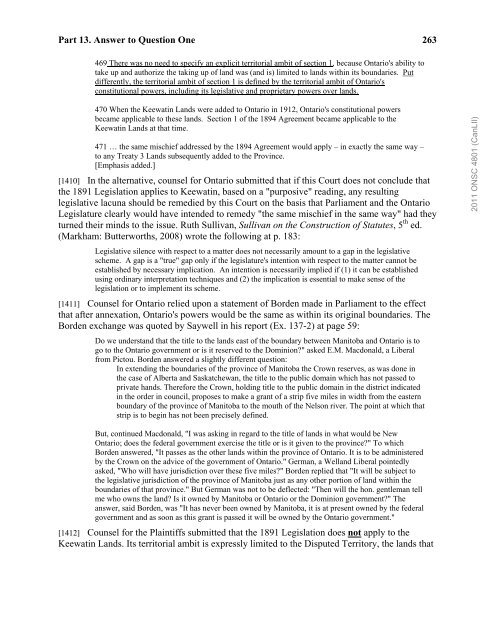Keewatin v. Minister of Natural Resources
Keewatin v. Minister of Natural Resources
Keewatin v. Minister of Natural Resources
- No tags were found...
You also want an ePaper? Increase the reach of your titles
YUMPU automatically turns print PDFs into web optimized ePapers that Google loves.
Part 13. Answer to Question One 263469 There was no need to specify an explicit territorial ambit <strong>of</strong> section 1, because Ontario's ability totake up and authorize the taking up <strong>of</strong> land was (and is) limited to lands within its boundaries. Putdifferently, the territorial ambit <strong>of</strong> section 1 is defined by the territorial ambit <strong>of</strong> Ontario'sconstitutional powers, including its legislative and proprietary powers over lands.470 When the <strong>Keewatin</strong> Lands were added to Ontario in 1912, Ontario's constitutional powersbecame applicable to these lands. Section 1 <strong>of</strong> the 1894 Agreement became applicable to the<strong>Keewatin</strong> Lands at that time.471 … the same mischief addressed by the 1894 Agreement would apply – in exactly the same way –to any Treaty 3 Lands subsequently added to the Province.[Emphasis added.][1410] In the alternative, counsel for Ontario submitted that if this Court does not conclude thatthe 1891 Legislation applies to <strong>Keewatin</strong>, based on a "purposive" reading, any resultinglegislative lacuna should be remedied by this Court on the basis that Parliament and the OntarioLegislature clearly would have intended to remedy "the same mischief in the same way" had theyturned their minds to the issue. Ruth Sullivan, Sullivan on the Construction <strong>of</strong> Statutes, 5 th ed.(Markham: Butterworths, 2008) wrote the following at p. 183:Legislative silence with respect to a matter does not necessarily amount to a gap in the legislativescheme. A gap is a "true" gap only if the legislature's intention with respect to the matter cannot beestablished by necessary implication. An intention is necessarily implied if (1) it can be establishedusing ordinary interpretation techniques and (2) the implication is essential to make sense <strong>of</strong> thelegislation or to implement its scheme.[1411] Counsel for Ontario relied upon a statement <strong>of</strong> Borden made in Parliament to the effectthat after annexation, Ontario's powers would be the same as within its original boundaries. TheBorden exchange was quoted by Saywell in his report (Ex. 137-2) at page 59:Do we understand that the title to the lands east <strong>of</strong> the boundary between Manitoba and Ontario is togo to the Ontario government or is it reserved to the Dominion?" asked E.M. Macdonald, a Liberalfrom Pictou. Borden answered a slightly different question:In extending the boundaries <strong>of</strong> the province <strong>of</strong> Manitoba the Crown reserves, as was done inthe case <strong>of</strong> Alberta and Saskatchewan, the title to the public domain which has not passed toprivate hands. Therefore the Crown, holding title to the public domain in the district indicatedin the order in council, proposes to make a grant <strong>of</strong> a strip five miles in width from the easternboundary <strong>of</strong> the province <strong>of</strong> Manitoba to the mouth <strong>of</strong> the Nelson river. The point at which thatstrip is to begin has not been precisely defined.2011 ONSC 4801 (CanLII)But, continued Macdonald, "I was asking in regard to the title <strong>of</strong> lands in what would be NewOntario; does the federal government exercise the title or is it given to the province?" To whichBorden answered, "It passes as the other lands within the province <strong>of</strong> Ontario. It is to be administeredby the Crown on the advice <strong>of</strong> the government <strong>of</strong> Ontario." German, a Welland Liberal pointedlyasked, "Who will have jurisdiction over these five miles?" Borden replied that "It will be subject tothe legislative jurisdiction <strong>of</strong> the province <strong>of</strong> Manitoba just as any other portion <strong>of</strong> land within theboundaries <strong>of</strong> that province." But German was not to be deflected: "Then will the hon. gentleman tellme who owns the land? Is it owned by Manitoba or Ontario or the Dominion government?" Theanswer, said Borden, was "It has never been owned by Manitoba, it is at present owned by the federalgovernment and as soon as this grant is passed it will be owned by the Ontario government."[1412] Counsel for the Plaintiffs submitted that the 1891 Legislation does not apply to the<strong>Keewatin</strong> Lands. Its territorial ambit is expressly limited to the Disputed Territory, the lands that
















